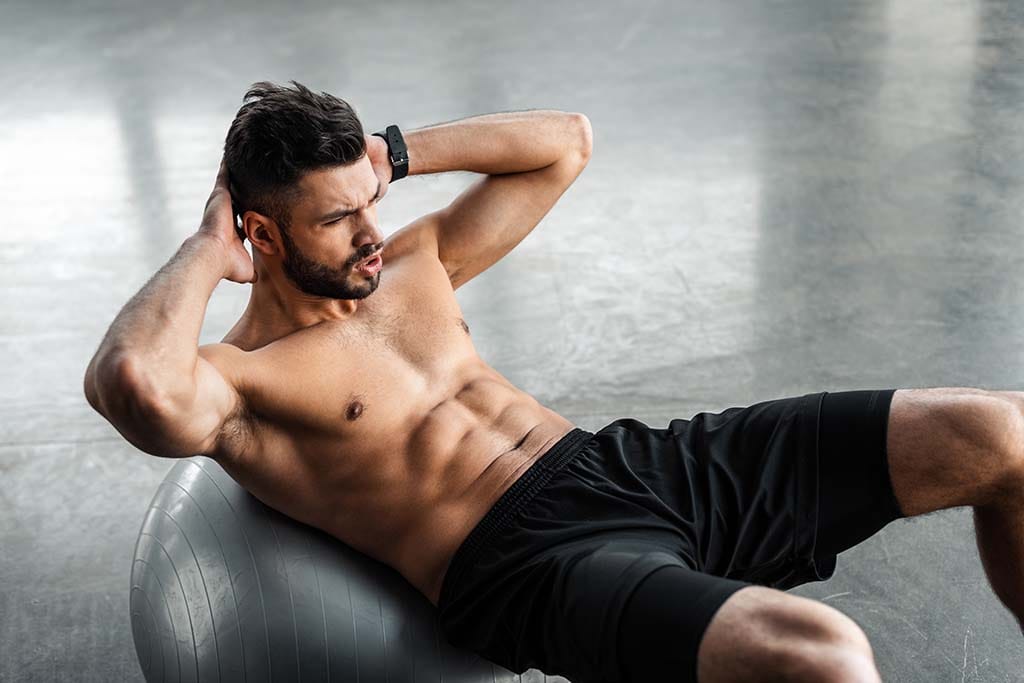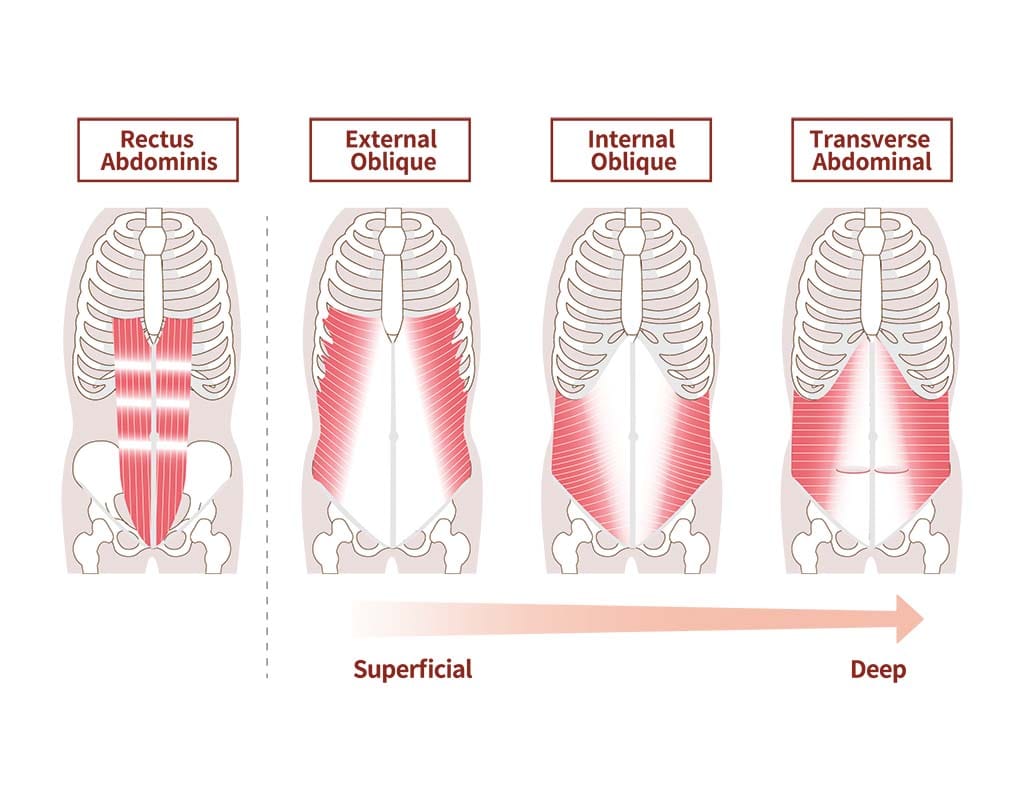Heel Tap Abs: No-Equipment Workout for a Stronger Core
At Flex, we believe that great workouts can happen anywhere and with the simplest of equipment: it’s all about the effort you’re putting in!
Are ab crunch machines, exercise balls, or the best weighted ab exercises the only way to build a stronger core?
This particular workout we’re exploring comes with no equipment required at all. Heel tap ab workouts are your-body-only exercises with the optional use of a simple exercise mat.
If you want, you can take this core building move anywhere in the world with you, all you need to do is show up. In this article, we’ll explore heel tap abs. We’ll provide a how-to guide, simple modifications, and explore the benefits that come along with this move.
We’ll also look at tips and tricks for success and what muscles heel tap abs work. With that said, here’s our guide to this simple abdominal move to strengthen your abdominal and oblique muscles.
What Are Heel Tap Abs?
Heel taps, also known as “heel touchers,” are an effective ab exercise that targets the oblique muscles (waist muscles) on the sides of your abdomen.
In this move, you reach for your heels in a side-to-side motion while lying on your back. This helps to “crunch” the oblique muscles, toning them up and strengthening the core.
Here’s a simple explanation of how to do heel taps:
Heel Taps for Abs— How-To
- Set-Up: Lie down on your back. You can optionally use an exercise mat for comfort. Bend your knees and place your feet flat on the floor, about hip-width apart. Position your arms at your sides, palms facing down.
- Body Position: Lift your head, neck, and shoulders slightly off the ground. Brace your core. Keep your chin slightly tucked in and your eyes focused on the ceiling so you don’t crunch your neck up.
- Action: Reach your right hand toward your right heel, bending at the right side of your waist and contracting your oblique muscles.
- Reverse: Come back through center, keeping your shoulders up off the ground, then immediately switch sides and reach your left hand toward your left heel, contracting the left oblique muscles.
- Reps: Aim for 3 sets of 15-30 taps on each side.
Tips and Tricks to Make Heel Taps Easier
Follow these tips to do a better and easier heel tap without getting injured or hurt your neck or other parts of your body.

Reduce Your Range of Motion
Adjust Heel Distance: Make your work easier by bringing your heels closer to your glutes. That way, your body has less distance to travel! The exercise will be slightly easier while still engaging your obliques.
Use Small Movements: Focus on smaller, controlled movements rather than overreaching with your arms. Remember, they’re HEEL taps, so don’t feel the need to surpass your heels if you’re just beginning to learn this move. This helps you hold onto your form and puts less strain on the neck and back.
Neck Support
Use a Towel or Mat: Put a rolled-up towel, yoga mat, or small cushion under your head and neck to provide more support. This way, you won't “crunch” the neck up as you move. It’s a way to help reduce neck strain and makes it easier to hold yourself in a lifted position. That way, you're concentrating all the work on your abs, not your neck!
Engage the Core: Make sure your core is actively engaged. This will help you lift your shoulders slightly off the ground, so there’s less burden on your neck muscles.
Controlled Breathing
Exhale on Effort: Breathe out as you reach towards your heel, and inhale as you return to the starting position. That way, you keep a rhythm to your movement. It also helps to ensure you’re not holding your breath. Although holding your breath through strain is tempting, it can actually make a tough workout feel even harder.
Steady Pace: Go slowly and use control. Thrashing back and forth defeats the purpose of this exercise. Slower movement allows you to focus on your form and muscle engagement without rushing, so the move feels more manageable.
Smaller Sets
If you’re new to heel taps or finding them extra difficult, start with fewer reps and sets. For instance, you could start with 2 sets of 10-15 taps on each side until this set-rep range feels comfortable for you. Slowly increase this number as your strength and endurance improve.
If abs are a trouble area for you, keeping track of your progress and improvements each time you work out can be a major motivator! Try using a fitness tracker app like the Flex Fitness app to log your sets as you progress.
This way, you’ll have a starting point each time you work out and can ensure that you’re building on load or repetition progression so you’re getting a harder workout and better results over time.
What Muscles Do Heel Tap Abs Work?
Now that you know how to do heel tap abs, it's time to learn about the muscles that this exercise targets.

Obliques
Your external and internal obliques are chiefly responsible for what’s called lateral flexion (bending side to side). They also help you rotate your trunk when you twist at the waist and stabilize the spine.
When you reach side to side in heel taps, you’re contracting your obliques, helping to build strength and define your waist. Obliques are often neglected when it comes to ab workouts even though many are on the quest to slim down their waists.
If you’re interested in developing this muscle group, you may be wondering: do Russian twists make your waist smaller? And should I work out my abs if I have belly fat? Understanding more about the abdominal muscles and what your goals are in this regard can help you come up with an action plan when it comes to building these muscles up.
Rectus Abdominis
These are your "six-pack" muscles on the front of your torso. Your rectus abdominis flexes the lumbar spine (lower back) so you can bend forward.
During heel taps, your rectus abdominis engages to help you hold your body up throughout the exercise.
Transverse Abdominis
The transverse or transversus abdominis is the deepest layer of abdominal muscles. It’s part of what’s called your “deep core.” This muscle wraps around your body like a corset and helps keep your spine and pelvis stable. It also holds all your internal organs that sit in the abdominal cavity.
Hip Flexors
This group of muscles brings your thighs towards your body, flexing across the hip joint.
When you do heel tap abs, hip flexors help maintain your leg and pelvis position so your lower body stays stable while your upper body moves.
Benefits of Heel Tap Abs
What are the benefits of doing heel tap abs?

1. Targeted Oblique Workout
Heel taps mostly target the oblique muscles, helping to tone and define the sides of your abdomen. We often tend to skip the obliques in other core work, focusing more on the rectus abdominis (six-pack), so this workout can help with the more neglected oblique muscles.
Building an abdominal strength program that targets all parts of the abs— not just the area that you want to show off— makes for a more holistic approach to your workout routine.
2. Core Strengthening
By engaging your entire core, heel tap abs can help you with overall core stability and strength. This can serve you well in all sorts of sports, training and everyday movement.
3. Flexibility & Mobility
The side-to-side motion enhances flexibility in the oblique muscles and improves the range of motion in your torso. Keeping track of how far towards your heels you’re able to reach can even act as a mobility test to assess your core and spinal mobility.
4. Low-Impact
Heel taps are a low-impact exercise. In elderly populations and overweight individuals with joint issues, low-impact workouts are some of the best moves you can do to stay active without added strain or injury risk!
You don’t need to jump around or put a lot of strain on your joints since this move is mostly stationary, so it helps a lot if you tend to experience joint pain or soreness after you exercise. If you struggle with problems like sore quads or other muscular pain after your workouts, low impact options can be just the thing you need!
This also makes heel tap abs good exercise for people at most fitness levels or those with prior injuries. making them an accessible option for strengthening the core without putting excessive strain on your body.
5. Take Anywhere
This workout is a lot more portable than anything you’d do with gym equipment. Because heel tap abs don’t require dumbbells, barbells, or anything besides an optional yoga or workout mat, they’re a good option for travel or outdoor workouts.
If you find yourself on a trip, stumped with trying to think of a creative way to get a workout in outside of the gym, these are a handy move that you can bust out of your back pocket.
Big Picture
Heel tap ab exercises offer a range of benefits, primarily targeting and toning the oblique muscles for a more defined waistline.
They engage the entire core, enhancing overall strength and stability, which is crucial for various physical activities. The controlled side-to-side motion improves flexibility and range of motion in the torso.
Furthermore, heel taps are low-impact. Lower-impact workouts are less taxing on your joints. For those with injuries, who are elderly, overweight, or simply seeking a workout with less chance of joint pain, this type of exercise is a good fit.
Heel tap abs are an effective way to strengthen and sculpt your core with little excessive strain on your body.
References
Kennard, J. A., & Woodruff-Pak, D. S. (2012). A comparison of low- and high-impact forced exercise: effects of training paradigm on learning and memory. Physiology & behavior, 106(4), 423–427. https://doi.org/10.1016/j.physbeh.2012.02.023
Khanfir MA, Awicha HB, Masmoudi L, Hmadou FB, Dardouri W, Alardan S, Nouira S, Zouch M. Effects of Different Low-Intensity Exercise Types on Duration, Energy Expenditure and Perceived Exertion in Obese Individuals. International Journal of Environmental Research and Public Health. 2022; 19(8):4893. https://doi.org/10.3390/ijerph19084893
Lee, J. S., Kim, T. H., Kim, D. Y., Shim, J. H., & Lim, J. Y. (2015). Effects of selective exercise for the deep abdominal muscles and lumbar stabilization exercise on the thickness of the transversus abdominis and postural maintenance. Journal of physical therapy science, 27(2), 367–370. https://doi.org/10.1589/jpts.27.367
Plotkin, D., Coleman, M., Van Every, D., Maldonado, J., Oberlin, D., Israetel, M., Feather, J., Alto, A., Vigotsky, A. D., & Schoenfeld, B. J. (2022). Progressive overload without progressing load? The effects of load or repetition progression on muscular adaptations. PeerJ, 10, e14142. https://doi.org/10.7717/peerj.14142
Tse, A. C., Wong, T. W., & Lee, P. H. (2015). Effect of Low-intensity Exercise on Physical and Cognitive Health in Older Adults: a Systematic Review. Sports medicine - open, 1(1), 37. https://doi.org/10.1186/s40798-015-0034-8
Related articles


Get fit with Flex
Build muscle & lose weight fast for free.
Available on iPhone + Apple Watch





